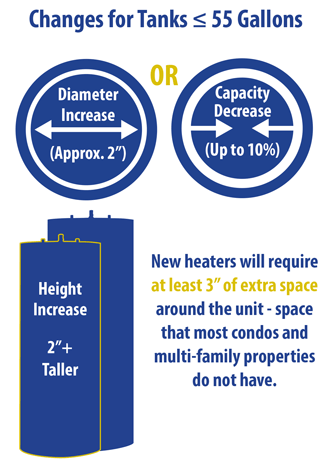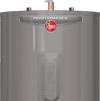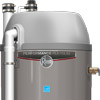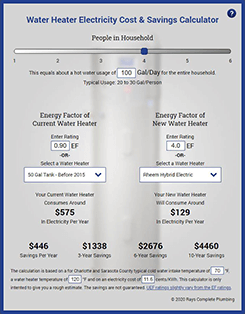What You Need to Know About the NAECA 2015 Water Heater Efficiency Standards
Updated 2/19/15
What is NAECA?
On April 16, 2015, the Department of Energy (DOE) will make effective its new energy efficiency mandates, as part of the National Appliance and Energy Conservation Act (NAECA). This update will affect all household appliances manufactured for sale in the U.S., and Canada will soon follow in their implementation of similar energy efficiency upgrades. This new update was first announced in April 2010. Part of this efficiency standards update will require nearly all residential electric, oil, gas and tankless gas water heaters to carry higher Energy Factor (EF) ratings. The new rule does not preclude the installation of non-compliant products that are manufactured before April 16, 2015.
Both electric and gas water heaters will now be broken down into two size categories:
- 20 to 55 gallon; and,
- 55 gallon and larger.
| 2015 NAECA Efficiency Guidelines Energy Factor (EF) |
||||
|---|---|---|---|---|
| Gallon Capacity |
Gas Standards | Electric Standards | ||
| Current | New 2015 | Current | New 2015 | |
| 30 | 0.61 | 0.63 | 0.93 | 0.95 |
| 40 | 0.59 | 0.62 | 0.92 | 0.95 |
| 50 | 0.58 | 0.60 | 0.90 | 0.95 |
| 60 | 0.56 | 0.75 | 0.89 | 1.99 |
| 66 | 0.54 | 0.75 | 0.88 | 1.98 |
| 75 | 0.53 | 0.74 | 0.87 | 1.97 |
| 80 | 0.52 | 0.74 | 0.86 | 1.97 |
| 100 | 0.48 | 0.72 | 0.84 | 1.94 |
| 120 | – | – | 0.81 | 1.92 |
We estimate that less than one (1) percent of the water heaters installed in Charlotte and surrounding counties are larger than 50 gallons. The most popular water heater capacity, rather, is anywhere between 30 and 40 gallons.
How Will These Changes Affect You?
Installation Challenges for Condominiums and Multi-Family Residences
In order to comply with these new federally-imposed standards, water heater manufacturers will be forced to alter their equipment designs to improve the insulation. This will mean one of two things – either the diameter of the heaters will increase significantly, or the capacity will decrease – potentially up to 10%.
Recognizing that installations in condominiums and similar structures are space defined, manufacturers are most likely to reduce tank capacities to overcome installation conflicts. Less dramatic efficiency standard increases several years ago resulted in reduced capacities in some 40 and 50 gallon water heaters to 38 gallon and 47 gallon respectively.
As of mid-February, one major manufacturer has now confirmed capacity decreases in some water heaters of at least 10%. Other NAECA compliant water heaters will have a confirmed 1 ¼” – 2″ increase in diameter.
While some single family homes may by impacted by this new standard, most, if not all residential condominium and apartment units certainly will. The floor plans and common plumbing elements typically found in these types of occupancies will limit or preclude relocation of the tank type water heater. Accordingly, when replacing an existing water heater after April 16, 2015 with a NAECA 2015 compliant heater, the owners of condominiums and apartment units will most likely be forced to install a tank with significantly less volume. This would mean either changing their hot water usage habits, or increasing the storage temperature and installing an ASSE approved mixing valve to attempt to maintain their current hot water usage.


Price Increases and Inventory Availability
This is not the only issue presented by the new standards regulations. History tells us that whenever a change of this magnitude is instituted, prices of higher efficiency equipment are always affected. Following the last major efficiency upgrade, there was a price increase for the new standard equipment of between 8-12%. As of mid-February, we now know from one of the major manufacturers that these price increases on the new NAECA compliant products will be up to 40%. We can only surmise that all major water heater manufacturers will follow suit.
Equally difficult to pinpoint is exactly how long the existing equipment that will be rendered obsolete by the new standards will be available to consumer. Although manufacturers will be allowed to continue to sell off their inventory of equipment produced prior to April 16, 2015, we know that no manufacturer will want to be stuck with shelves full of obsolete inventory. We expect that production will be cut off far ahead of the April 16 deadline, and that a large portion of the available inventory will be acquired by large national homebuilders in order to delay the effects of the new NAECA standards on their operations. Any inventory that remains will likely be sold to distributors and consumers on an allocation only basis.
Replacement Options

Electric Tank Based Water Heater
≥ 55 Gallons – Creased dimensions OR decreased gallon capacity
< 55 Gallons - no longer available after 4/16/15

Tankless Electric Water Heater
Electricity demands will preclude the installation of tankless heaters in most instances.

Gas Water Heater
Expensive and labor-intensive to install. Gas is really only a viable if your home is already equipped with a gas water heater.
In order to comply with the new NAECA standards, besides opting for electric tank based water heaters under 55 gallons with increased size or decreased capacity, you, the homeowner or proerty manager, are also presented with the option of choosing a gas, tankless or hybrid heat pump water heater. However, gas is really only a viable option if your home is already equipped with a gas water heater. Having the necessary equipment and fittings installed to accommodate a gas powered system carries a high price tag. By the same token, power requirements will preclude the installation of tankless heaters in most instances.
The most viable of the three alternate options, then, is the hybrid heat pump water heater. Hybrid heaters are extremely energy efficient; for instance, one model from Rheem carries a 2.45 EF rating. Heat pumps function by transferring usable heat from once source to another – i.e., pulling heat from the air, compressing it and transferring it to the water in the tank. Year-round warm temperatures make Southwest Florida homes prime candidates for heat pump water heaters, as they are able to function at top efficiency. Other benefits include a 12 year warranty (double the standard warranty of electric heaters), and the fact that heat pumps exude cool air to the space around them.
The only possible disadvantage to the hybrid heat pump water heat is the size of the overall unit. Currently, the hybrid heaters are marginally wider and significantly taller. However, we have been advised that there will be some change in dimensions when the manufacturers re-tool for the new line. Either way, it can be safely assumed that greater than 99% of installations will not be affected by physical conflicts related to size change.
Hybrid Heat Pump Water Heater
Rheem Prestige™ Series


In light of all of this information, as a homeowner, condo owner or property manager, what action should you take?
First, start by considering the age of your current water heater. The standard warranty for an electric water heater is 6 years. Units typically begin to show signs of significant wear after about 7-8 years. This is when risk of leaks resulting in costly property damage is the greatest.
If you find that your water heater is due for replacement, consider the following options:
 Purchase a new water heater that meets the current standard. If you act soon, while these products with lower EF ratings are still available, you will be able to put off the entire issue with the new NAECA standards for at least another six years. Your tank capacity, and therefore your hot water usage, can remain the same, and you won’t have to worry about the equipment size increases and the resulting space considerations in your home, condo or apartment unit.
Purchase a new water heater that meets the current standard. If you act soon, while these products with lower EF ratings are still available, you will be able to put off the entire issue with the new NAECA standards for at least another six years. Your tank capacity, and therefore your hot water usage, can remain the same, and you won’t have to worry about the equipment size increases and the resulting space considerations in your home, condo or apartment unit. Upgrade to the new 2015 NAECA standards-compliant equipment now. Purchasing a more energy-efficient heater ahead of the April 16th deadline will allow you to avoid the imminent price increases on this type of equipment. Plus, you can already start enjoying the added benefits that high-efficiency equipment will bring, such as lower electricity usage and reduced energy costs.
Upgrade to the new 2015 NAECA standards-compliant equipment now. Purchasing a more energy-efficient heater ahead of the April 16th deadline will allow you to avoid the imminent price increases on this type of equipment. Plus, you can already start enjoying the added benefits that high-efficiency equipment will bring, such as lower electricity usage and reduced energy costs. Wait to act until after April 16, 2015. This decision will give you the benefit of knowing for certain just what the efficiency upgrades will entail and allow you to purchase the latest products, however you will no longer be able to opt for the currently-available lower cost equipment with lesser efficiency ratings. You will be forced to purchase 2015 standard equipment, for higher prices, and with either less capacity or larger physical dimensions.
Wait to act until after April 16, 2015. This decision will give you the benefit of knowing for certain just what the efficiency upgrades will entail and allow you to purchase the latest products, however you will no longer be able to opt for the currently-available lower cost equipment with lesser efficiency ratings. You will be forced to purchase 2015 standard equipment, for higher prices, and with either less capacity or larger physical dimensions.
No matter how you decide to handle these new 2015 NAECA standards regulations, whether you upgrade your equipment now or in the future, always remember to hire a licensed contractor.
A licensed contractor has the skills, knowledge and experience, not to mention the proper tools, to advise you on the best water heater choice for your home, and to install your new unit correctly and efficiently, the first time. They will also handle all the necessary county permits for you, and provide a higher grade of equipment than is offered by your local home improvement store.
Contact Us for More Information
If you have any questions about the NAECA 2015 efficiency standards, please contact us. We are your go-to resource, ready to provide guidance and peace of mind while helping you make any necessary transitions in your home.






